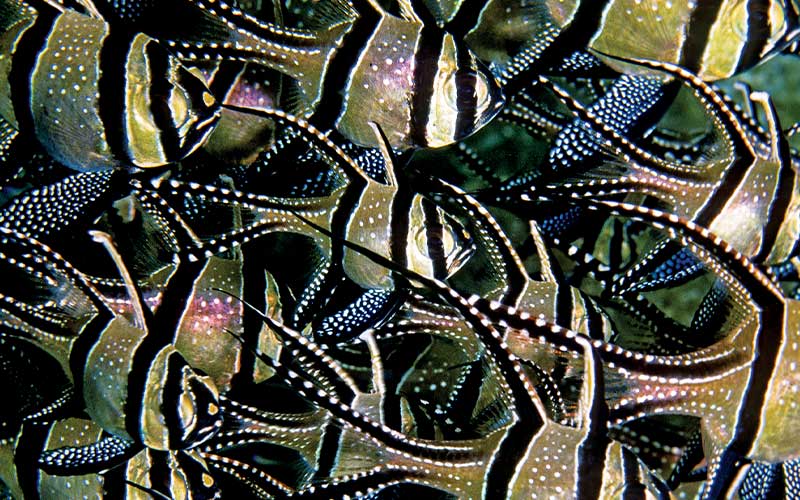A few years back I read an intriguing book titled The Botany of Desire by Michael Pollan. The author’s premise used examples of apples, tulips and marijuana to explain how many plant species have exploited human desires to flourish. In his account of apples, Pollan relates the tale of a 19th-century American entrepreneur popularly known to us as Johnny Appleseed, who made a fortune traveling down the Ohio River just ahead of settlers and establishing apple-seedling nurseries. While the settlers’ desire for sweetness and, more important, cider were being satisfied, the apple tree spread across a new continent.
Although a bit of a stretch, similar scenarios seem to be playing out in the marine world. The Indo-Pacific lionfish (Pterois volitans) is an infamous example. But a much more benign invasion of sorts is playing out on the other side of the world. Market demand for the strikingly beautiful Banggai cardinalfish (Pterapogon kauderni) has caused the species’ population numbers to plummet rather than proliferate.
Unknown except for a single 1933 specimen, the two-inch beauties were rediscovered in 1995 by ichthyologist Gerald Allen. A few months after his initial encounter, Allen flashed an image of the handsome species on the screen during a presentation to a national gathering of aquarists. Jaws dropped, and eyes popped. The stylish little fish became an overnight sensation and fueled a Banggai fish industry that now removes an estimated one million fish from the wild each year. As would be expected, such unregulated and heavy-handed exploitation has sent the endemic population plunging toward extinction.
But the tale has a twist. In the year 2000, about 50 Banggai cardinalfish disappeared from a tropical fish exporter’s holding pen in Lembeh Strait, located approximately 250 miles north of the species’ natural home. It remains unknown whether the cardinalfish escaped or were intentionally released, but regardless, the gang of fugitives took refuge in a nest of long-spined sea urchins in the shallows of a small island. Their new location suited them, for their numbers topped 600 within a year. Ten years later, descendents of the original band continue to spread down the strait.

Although not to be applauded or duplicated, the Lembeh invasion appears to have produced negligible environmental impact. For the most part, the waters’ new inhabitants dine on a renewable source of drifting zooplankton and amiably share anemone homes with commensal anemone fishes and crustaceans. They group in clusters numbering a dozen or more, and their appearance creates fashionably flowing mosaics of black- and silver-specked fins. Adding to their attraction, they provide patient divers the opportunity to observe one of the most novel reproductive pageants in the world of marine fishes.
The males of numerous species of jawfishes and cardinalfishes incubate eggs inside their mouths; however, their broods, often numbering in the thousands, are only tiny specks of life when released after a few days.
No such luck for the Banggai cardinalfish. Following a passionate courtship ballet, the female releases a bundle of 30 to 50 bubblegum-pink eggs, each the size of a peppercorn. Addled with ecstasy, the hormone-twitching male sucks up the bundle with a single slurp, instantly expanding his jowls (think about stuffing 40 peppercorns into the quarter-inch mouth of a two-inch fish). This physical distinction is the easiest way to spot a mouthbrooding Banggai. Another hint: The majority of courtship and egg transfers occur during daylight hours around the full moon. Twenty days later, the fry hatch inside the mouth, where they stay for 10 days more. When a new generation of Banggai cardinalfish emerges, they are perfectly formed quarter-inch replicas of adults.
Such a Herculean effort toward parental care pays big dividends for the survival of offspring, but it greatly limits the spread of progeny and genes. However, the tradeoff just might be the salvation of this splendid species; the extensive nurturing makes Banggai cardinalfish one of the easiest fish to breed in captivity. Unfortunately, captive-bred cardinalfish are more expensive than wild-caught imports, so their ultimate destiny remains uncertain.
Explore More
© Alert Diver — Q1 Winter 2011

